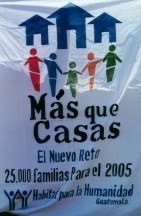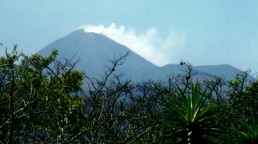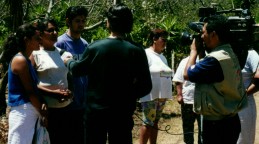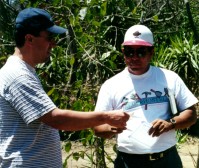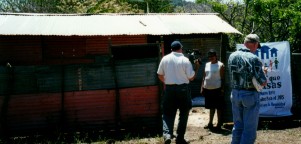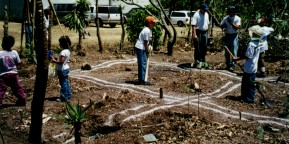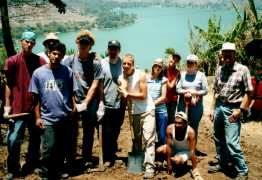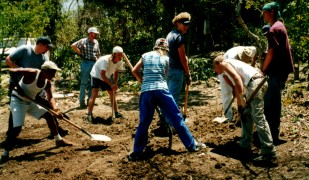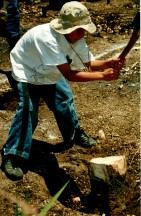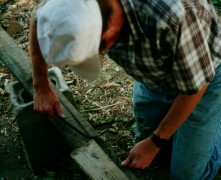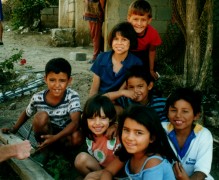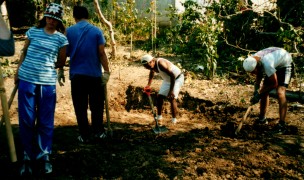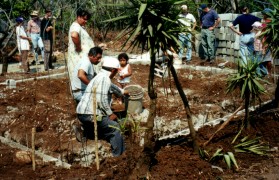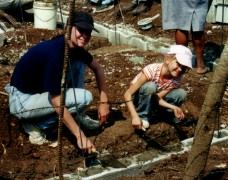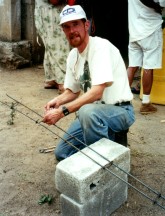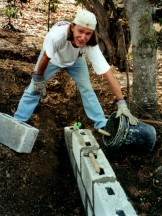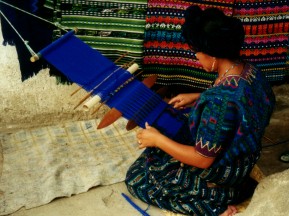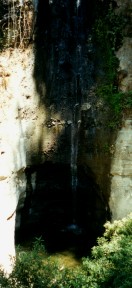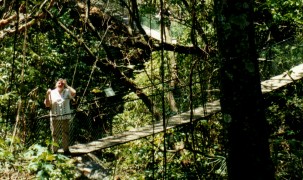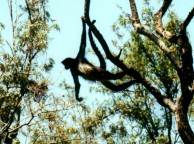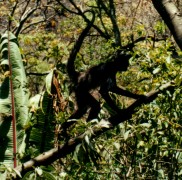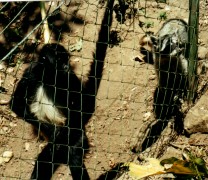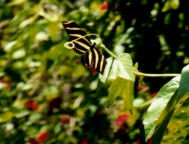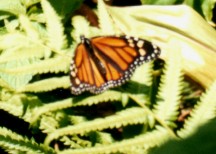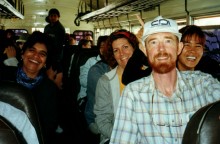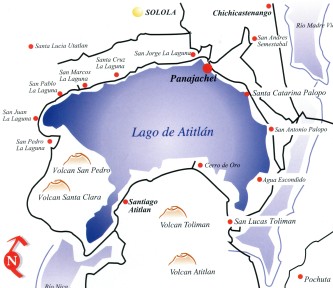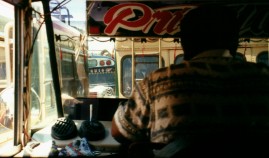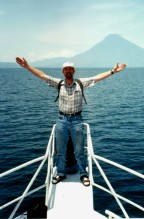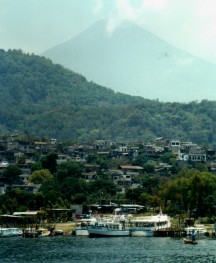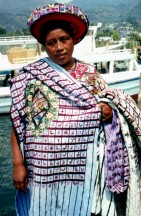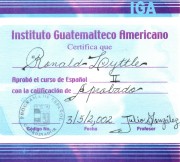WELCOME TO GUATEMALA!
EPISODE #10
Friday, 05-10-02
Today is Mother's Day down here, and I have the day off from IGA. Deb, however, is teaching
as usual. Terecita said that in the Philippines it is also on a specific date, but that in
Finland (she's married to a Finn) it is on Sunday like in the U. S. Didn't think to ask
about Russia and Syria.
Remember last Episode when I was talking about the sunny weather? As I was sending it
out to everybody it started to rain. Not long, not hard, but rain. The first of the
season, I assumed. Then it rained again the next night, with thunder and lightning, even.
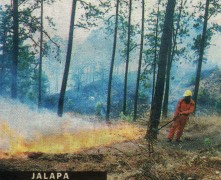 Prensa Libre Photo |
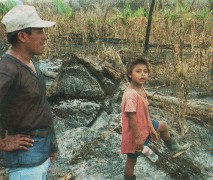 Prensa Libre: Alberto Ramirez |
But it turns out that it hasn't rained since, although there have been clouds in the mornings, and
the humidity has been high at times. The rain is late; it should have started by now on a
regular basis. During the day it has gotten quite warm, probably the warmest of the year.
Doesn't look good for the farmers and their crops. The paper also reports a lot of fires in
various parts of the country destroying a lot of trees and crops.
As this Episode's "Web Special", under the category of "the grass is always
greener...", I offer "A Tale of Two Commutes," published
in The Guatemala Post. Have you ever thought about "going native" down here?
What would you be giving up? What would you gain? Check it out.
I promised to tell you about an adventure of a different sort. The account follows, with
a brief interruption, written at the time it happened.
Saturday 4-6-02, 9:00 PM. Today we got "down and dirty"!
In November Habitat for Humanity built its 10,000th house in Guatemala, after coming here in
1979 in response to an earthquake.
Today, as Volcan Pacaya smoked in the background, a group of about 20 volunteers from Union Church
joined a local Habitat committee and two landowners to break ground on two new houses in
Amatitlán, overlooking Lake Amatitlán south of Guatemala City. These are the
first houses to be built in this area, this is a brand new committee, and everybody was excited.
Even Channel 3 had a cameraman out for an interview. We also presented a check for some
Q28,000 to the committee from the Christmas offering. We actually had to turn away
volunteers, as paperwork for an expected third house wasn't completed. Hopefully by next
Saturday when we return that house will be started or ready to start. We will be back to
work on the first two, and they should be finished in two weeks or so, we are told.
One house is being built next to a current house built of "lamina," corrugated metal,
where the owner lives. She was out there digging and shoveling with the rest to dig the
foundation trenches.
The other site, where I worked, was further down the hill, with a great view of the lake.
Only problem: it wasn't flat, so we had to dig out the upper corner to fill in the lower.
This owner is renting a house elsewhere. He also was picking and shoveling.
To get a house built you have to submit an application to the local committee (there has to BE
a committee, overseen by a regional committee and the national office), and meet four criteria:
1) you need a house (you don't have one, or it isn't "decent"); 2) you must own the land
(although there is a U. S. group that is raising money to buy property for Habitat); 3) you must
be able to pay for the house (average is Q125/mo. for 8 years, $1500); 4) you must invest
"sweat equity" in your home and the others being built at the same time (thus the two
picking and shoveling with the rest of us). In return you get a house of cinderblock
construction, reinforced with rebar (to withstand earthquakes) averaging 46 sq. m. or 415 sq. ft.,
costing about $1700. It probably has no plumbing (no water supply), and usually no wiring
unless there is electricity around it.
It being a hot day, Deb mostly hung out and took pictures for the church record, while I picked
and shoveled until after lunch. Then I found where Vicente ("vi-CEN-teh" like the
president of Mexico), the construction boss for our site, was cutting and bending steel, and
started helping him. Watching him bend 1/4-in. steel rod into rectangles to give shape to
four rebar rods (you wire them together for a framework), I decided that I could do that, so he
was able to cut more and start wiring one reinforcement.
I soon had a crew of "helpers", seven neighbor kids watching and feeding me steel lengths
to bend, using the "jig" he had made, and a special tool. I told them my name and
got theirs, then the questions started: where I'm from, why I'm here, do I have any children,
etc. Talking to them got those rods bent in a hurry! Then I sent a couple up to a
little tienda (store) a block up the road to buy cold sodas for Q2.75 each. I had
previously shared one with Vicente, and told them to bring me one, and get two for themselves.
Since I also shared this one with him, I scored a lot of points with the "locals".
I also helped them with some English words, like how to say "THank you" instead of
"TSank you".
I had also explained to Vicente who we were, that a group would be back next Saturday to
continue (he told me that the site would look very different then, as they will have been working
on it all week), and also again in three months for another round of house building. He
seemed quite impressed, as voluntarios are rather uncommon. The leaders at Union
Church see this as a chance to be involved in a local community (not that far away), building
relationships, opening up inroads for the Gospel. I know seven kids that will be looking
for me next Saturday.
Oh, yes, my back is very stiff from swinging that pick, and I wore a blister from the bending
tool, but two people are getting decent and affordable houses, I made some new friends, and the
word about Habitat (and hopefully the Word) will spread in Amatitlán. It was a great
day!
Monday 4-15-02. Today is tax day back in the States, for you poor slobs that still have
to pay taxes. Here we have to file an extension, then after June 26 (a year after we came
here) we file for the first part of 2001, since all income since then is tax exempt as long as we
stay out of the country for at least 330 days out of that year. We were "home" at
Christmas for not quite three weeks, so we just have to make sure we don't come back to Oregon too
soon. Any time after July 26th will count toward next year. What we are doing is
changing our tax year from Jan. 1-Dec. 31 to July 27-July 26, if that makes any sense to you.
One teacher came home from Japan a week early, and "had" to go hang out in Mexico for a week to
preserve his exemption.
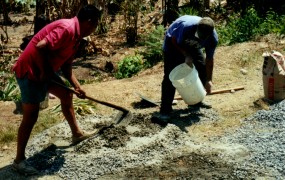 Mixing Concrete the Hard Way |
Saturday a much smaller crew went back to Amatitlán; it seems that there was a basketball
game at one of the schools that pulled some people that were planning on coming.
Nevertheless we showed up back at the sites, and were rather disappointed. We were
expecting walls, and they were just starting the first blocks of the foundation. Turns out
the concrete blocks had just been delivered, so they couldn't work all week as anticipated.
In fact, our site got another load delivered while we were working, and you could tell the blocks
were still damp. The upper, level site got a bunch of blocks laid, but ours, being on a
slope, had to be stairstepped, and it was taking quite a while to get the first blocks laid
correctly, so we were off to a slow start.
I had made copies of key pictures from last week for the two landowners, as well as a print of
my "helpers" for each of the seven. Were they ever excited! Parents too.
Photographs are a rarity.
I asked what I could do, and he put me to work tying two rebar rods together with wire and
elongated "C"-shaped pieces of 1/4-in. steel rod. A little trickier than bending
the rectangles like last week; the wire has to wrap just right or the rods aren't held properly.
Took me a while to get the "hang" of it, but managed to get three 20-ft sections put
together, tying every foot. That's 38 ties per unit, times three (minus 4 I didn't finish)
or 110 ties. No wonder my hands were sore at the end. Couldn't wear gloves, as they
would make me too clumsy with the wire. My kids were back to help, but once they had strung
all the "C" pieces on the two rods there wasn't anything else to do, so they wandered off.
While progress wasn't as fast as hoped for, we did accomplish something, and while the church
commitment has been fulfilled, some people are talking about going back next Saturday to do some
more. It is going to take more than two weeks to build these houses! More news as it
happens.
What do you call a "baby shower" in Spanish? Well, since that
concept is imported from the States, they brought the name along: "Baby Shower".
We had a surprise one for Reina, the lady from Syria who is expecting. Her sister hosted
the party, and what a party! A total surprise to her, and a good time was had by all,
especially when it was time to eat. Lama had fixed so much food, including several Syrian
dishes, that we couldn't POSSIBLY eat it all, but we tried. And there were some nice gifts
for the baby (we know it is a girl). Played some games, like tear off a piece of toilet
paper you think measures her girth, and the closest one wins a prize. The other guys in the
class weren't there, but Julio our teacher was, and Maria's boyfriend, along with the two husbands
who stayed out in the living room. I did get to meet them, which was good. We also
had a couple of other IGA teachers, including Silvia from Curso Uno.
The weekend of the 20-21st we took off and went to Panajachel ("pa-na-ha-CHEL") to relax
and see more sights. "Chicken bus" to Antigua (see Episode #7), then a shuttle to
Pana. (Caught a ride back with a friend on Sunday.) Debated whether to walk the 4 km.
to Santa Catarina to do some shopping, or take a launcha (small passenger boat). Took
the launcha (and he waited for us to finish shopping). For Q5 a lady let me photograph her using a backstrap loom, which is
how much of the indiginous clothing is still woven, including the distinctive Santa Catarina
huipil ("wee-PEEL", the native blouse) she was wearing.
Didn't realize
that the place we chose to stay in Pana was next door to a tienda that would play music
until 11:00 or so and the windows HAD to be open for air... Oh, well, they eventually
turned it off, BUT THEN IT WAS BACK ON AT 6:00 SUNDAY MORNING! Sheesh. Never going
to stay THERE again even if it WAS only $15.
But after breakfast we walked back up the hill half-to-three-quarters of a mile to the entrance
road for a nature and butterfly reserve. Walk another half mile or so, and there it is!
The first thing you see is an herb garden, and while wandering around in that we notice some
interesting large flowers on a bush, then realize that it has cotton bolls on it! I have
never seen cotton growing, didn't realize that it has such large colorful flowers.
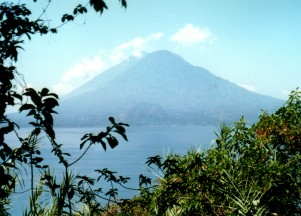 Front: Volcan Tolimán. Back: Volcan Atitlán |
After paying the Q40 entrance fee, we hiked a loop nature trail. They offer walking sticks,
and we found out why. You climb up, and up, then up some more! Some great views of
the lake through the trees, and eventually you come to a waterfall.
As you work your way
down you come to a series of suspension bridges, and then to a platform where you can watch spider
monkeys swinging through the trees. When a woman offers pieces of banana, you realize that
they can be beggars just like at the zoo. Even a raccoon gets in on the begging act.
Once back down, you cross the road and enter a netted area with all kinds of flowers blooming, and
this is where the butterflies are. We didn't see too many flying, but saw several cages
where caterpillars were being raised and pupas were waiting to hatch into adults. I suspect
that at times it is busy in there.
Friday the 26th of April was our Spanish classes field trip, and what a trip it was! We met
at the school at 7:00, got on a chartered bus and headed for Panajachel and a boat ride to Santiago
Atitlán. Debby and I were, of course, just in Pana the weekend before, but neither
of us had been to Santiago. She wanted to come with us, but couldn't get out of rehearsal
commitments at Maya. About 30 students and teachers actually made the trip. Got to
Sololá before coming down the hill to Panajachel, and it was market day and the streets were
jammed with vendors and buyers.
There are narrow streets and tight corners to negotiate to
get through the town, and with the bus we weren't sure if we could. At one point we had
buses on both sides and in front, and nobody was moving. Vendors had their "turf"
staked out, and they weren't moving out of the way! Honk all you want to. Finally
did make it, though, backing up to get around the corners.
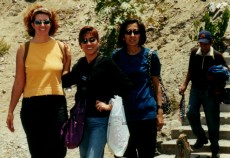 Tiffni, Terecita, Gurmail, and a vendor |
In Pana we piled off the bus and (eventually) got onto a rather nice cruise ship for the trip
across the lake. There was a projection on the front of the boat, so everybody was playing
"Titanic" for pictures. The trip takes about an hour, and we were accompanied by
a couple of boys doing their best to sell us necklaces and scarves and such (captive audience!)
and they even made a few sales.
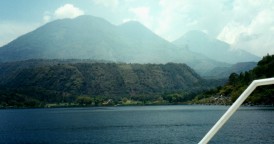 Left: Volcan Tolimán, Right: Volcan Atitlán |
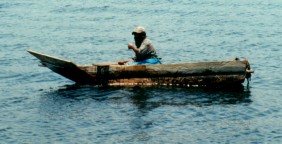 |
Santiago is on a finger of the lake, with two volcanoes behind it and another across the finger.
A lot of fishermen ply these waters for their livelihood.
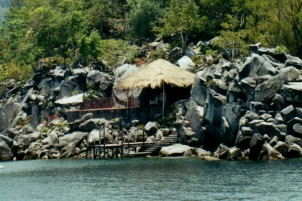 |
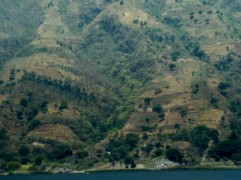 Farming, slopes of Volcan San Pedro |
When we got to the dock we were immediately mobbed with vendors wanting us to buy stuff, but we
were hungry and wanting to eat. Santiago is the town known for its gorgeous huipiles
("wee-PEE-les") with very ornate embroidery of flowers and birds, and Deb wanted me to
look for a blue one. I made the mistake of letting them know I was in the market for one,
and they were like a swarm of mosquitoes! I finally insisted that I wasn't buying ANYTHING
until I had eaten, and that I would indeed come back.
Terecita had brought a cooler of salad and sandwiches, and we finally found a restaurant where
we could sit outside, order a little more stuff, and eat our lunch. Then I went back to
look for a huipil. Found a really nice one I liked, and bought it for Q500.
But when I got back to the bottom of the street where we had started, I was mobbed again.
Two different ladies had blue huipiles that were nice, and both insisted that I HAD to buy
THEIRS. Since they were used and therefore only Q100 each I finally decided to take both.
THEN I got back to the dock and encountered the first lady I had talked to, and she was highly
put-out that I had bought from the others and not from HER. Well, I'm sorry, but I didn't
realize... and besides, I really didn't like her huipil as well; not as much embroidery.
She pursued me onto the boat, and I finally got rid of her by offering her Q5 to take her
picture. She grudgingly complied, but insisted that when I come back with my wife we HAVE
to buy from her. Sheesh!
Back at Pana people were slow about getting back to the bus, stopping to shop and load up on
fresh mangoes for Q.50 each (about $.07). Fortunately Sololá wasn't as jammed as in
the morning, and we made it through pretty easily. It is still a long ride back, however,
and I didn't get home until 7:45 PM. Hey, Deb liked the huipiles, so that was good.
Saturday night the 27th of April we got to hear the Mozart Chamber Orchestra of Vienna at the
National Theater. The "nose-bleed" seats were Q275 (up to Q450 on the floor), as
it was a benefit for the national kidney program here. But the theater is so good that the
sound and view are both excellent clear up in the corner where we were. And these people
know how to play it! As smooth as a professional recording. Picture this: all
the musicians are wearing formal jackets of various colors, and all have on white wigs (if you
have seen pictures of Mozart you get the idea), and the soloists also were dressed for the part.
Three encores, and the audience wanted more. Not our usual cheap concert, but well worth
the cost (and for a good cause).
Then the big thing at Colegio Maya that has been keeping Deb busy for a couple of months was the
production of "Charlie and the Chocolate Factory" (a la Willie Wonka).
That ran Thursday, Friday, and Saturday, and I ran lights and sound. Deb conducted a live
orchestra of her students (having arranged all the music, since it originally was just going to be
a piano, and she had all these kids that needed a performance venue, and...) It was amazing
the effects they came up with for a stage play, and on a small stage at that. And some
people were surprised to discover that the music was not a recording but coming from a
"live" orchestra (which they couldn't see until the end). Deb "scored"
more points.
Well, lastly, I took my final exam for Curso Dos on Friday, saw the test (two minor errors)
and got my certificate on Monday ("Aprobado" means "approved" or
"passed"), and started Curso Tres on Wednesday. We lost the
guys (Paul's mother died and he went back to England, Mario and Sam are working too much, and we
have no clue about Ronald from Holland). Also Reina's baby is due in less than a month, so
she is out for now. Three Korean ladies tried to take both Curso Dos y Tres at the
same time, but figured out that was a bad idea.
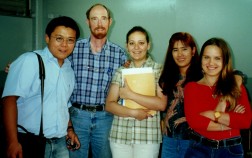 Sam (came back), Ron, Lama, Terecita, Maria |
 Otto Sequén |
We will be practicing what we learned in
Cursos Uno y Dos, reading and speaking. Hard to do when you haven't had it yet.
So we are four for now, Lama, Maria, Terecita, and I, and our teacher's name is Otto.
Should be a good class, and consolidate what we have been learning. Oh, I also will be
dropping out in June, as we are going to Europe! Will finish the last half when I return in
August.
Next time I'll let you know details of our European trip, which is still under construction.
PREVIOUS EPISODE. NEXT EPISODE.
Return to HOME PAGE.



